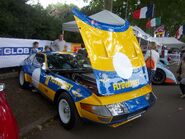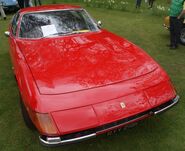
1973 Ferrari 365GTB/4 'Daytona'
The Ferrari 365 GTB/4, better known by the unofficial name Ferrari Daytona, is a Gran Turismo automobile produced from 1968 to 1973. It was first introduced to the public at the Paris Auto Salon in 1968 and replaced the 275 GTB/4. The Daytona was replaced by the mid-engined 365 GT4 Berlinetta Boxer in 1973.
Name[]
The unofficial Daytona name is reported to have been applied by the media rather than Ferrari and commemorates Ferrari's 1-2-3 finish in the February 1967 24 Hours of Daytona with the 330P4.
Vehicle specifications[]
Unlike Lamborghini's then-new, mid-engined Miura, the Daytona was a traditional front-engined, rear-drive car.
The engine, known as a Tipo 251 and developed from the earlier Lampredi V12 used in the 275 GTB/4, was a 4.4 L (4390 cc, 267.9 cid) DOHC V12 with a 60° bank angle, 365 cc per cylinder, 81 mm (3.2 in) bore and 71 mm (2.8 in) stroke, featuring six Weber twin carburettors (40 mm Solex twin carburettors were used alternatively). At a compression ratio of 9.3:1, it produced 352 PS (259 kW; 347 hp) and could reach 280 km/h (174 mph). 0-60 mph (97 km/h) acceleration was just 5.4 seconds. For the American version, slight modifications were made - the compression ratio was reduced to 8.8:1 and the exhaust system was equipped with a large central silencer, necessitating visible alterations to the primary pipes.
The 5-speed manual transmission (transaxle concept) was mounted in the rear for optimal weight distribution, and a 4-wheel independent suspension featured wishbones and coil springs.
Styling[]
Although it was also a Pininfarina design, as with many previous Ferrari road cars (by Leonardo Fioravanti), the 365 GTB/4 was radically different. Its sharp-edged styling resembled a Lamborghini more than a traditional Pininfarina Ferrari.
Early Daytonas featured fixed headlights behind an acrylic glass cover. This particular setup was completely abandoned in 1971 favor of retractable pop-up twin headlights due to new safety regulations in the U.S., which outlawed headlights behind covers.
Model variations[]
365 GTB/4 and GTS/4[]
The generally accepted total number of Daytonas from the Ferrari club historians is 1,406 over the life of the model. This figure includes 158 right-hand-drive coupes, 122 factory-made Spiders (of which 7 are right hand drive) made by Scaglietti — the Daytona body builder — 15 competition cars in three series with modified lightweight bodies and in various degrees of engine tune.
Historically, and especially since the mid-1980s and early 1990s, there has mostly been a considerable market price difference between a real Berlinetta and a real Spider. In hope for higher value and prospective sale revenue — or even because not too many factory Spiders were ever built — many Berlinettas were turned into convertibles.
Achievements and notoriety[]
.In 2004, the Daytona was voted top sports car of the 1970s by Sports Car International magazine. Similarly, Motor Trend Classic named the 365 GTB/4 and GTS/4 as number two in their list of the ten "Greatest Ferraris of all time".
In 1971, the Daytona gained notoriety when one was driven by Dan Gurney and Brock Yates in the inaugural Cannonball Baker Sea-To-Shining-Sea Memorial Trophy Dash. The pair won with an average speed of 80.1 miles per hour (129 km/h), completing the distance from New York to L.A. in 35 hours 54 minutes (2,876 miles (4,628 km)). The maximum National speed limit on American highways, introduced for safety, at that time was 55 m.p.h..
Competition versions[]
The first racing version of the 365GTB/4 was prepared in 1969: an aluminium bodied car was built and entered in the Le Mans 24 hour race that year (the car crashed in practice). Ferrari did not produce an official competition car until late in 1970. The official cars were built in three batches of five cars each, in 1970-1, 1972 and 1973. They all featured a lightweight body making use of aluminium and fibreglass panels, with plexiglas windows. The engine was unchanged from the road car in the first batch of competition cars, but tuned in the latter two batches (to 400 bhp (298 kW; 406 PS) in 1972 and then around 450 bhp (336 kW; 456 PS) in 1973).
The cars were not raced by the official Scuderia Ferrari team, but by a range of private entrants. They enjoyed particular success in the 24 Hours of Le Mans, with results including a 5th overall in 1971, followed by GT class wins in 1972, 1973 and 1974. In 1972 Ferrari 365 GTB/4s took the first 5 places of the GT class.
The final major success of the car was in 1979 (five years after production ended), when a 1973 car achieved a class victory (2nd overall) in the 24 Hours of Daytona.
Popular culture[]
A red Daytona Spyder was one of the "stars" of the 1976 film Gumball Rally. Other films in the 1970s featuring Daytonas were A Star Is Born, The Long Goodbye, Gone in 60 Seconds, The Swiss Conspiracy, and Herbie Goes to Monte Carlo. In 1988, a Daytona was featured in Rain Man.
- In the 1980s, the car gained new notoriety on the first two seasons of NBC's hit television series Miami Vice. The black car used in the series was a replica built on a Corvette chassis. Ferrari execs were not pleased that their company and one of their products was represented on TV by an imitation car. The Daytona replica was eventually destroyed on-screen and replaced with a donated Ferrari Testarossa, the company's newest model during the time.
- In the 1990 film The Rookie, a Ferrari Daytona is stolen from a valet parking service and loaded on a semi-tractor trailer by the thieves. It is later wrecked in a collision.
- It was also dedicated in song metaphorically by Chris Rea, titled "Daytona" for his 1989 album, The Road to Hell.
- The show Top Gear featured James May, in a 1.25 million pound power boat, racing Richard Hammond in a Ferrari Daytona from Portofino to Saint-Tropez. For May, the journey was rough, damaging the in-vehicle camera. Both Hammond and May were pulled over by the police. May won, but Hammond explained that the boat might have been the fastest way to complete the journey, but the car would always be the best method.
- The cover of the Carpenters 'Now and Then' album features Richard Carpenters red 365 Daytona coupe with Karen Carpenter in the front passenger seat.







